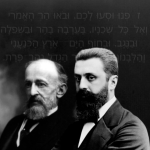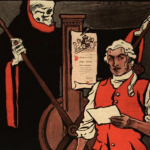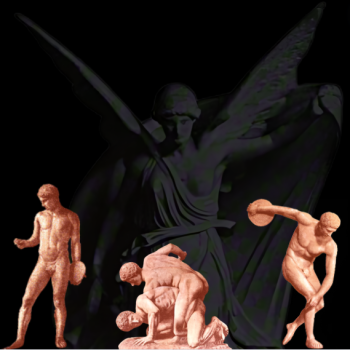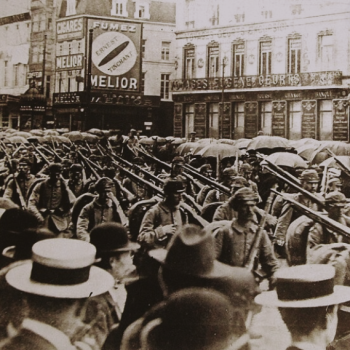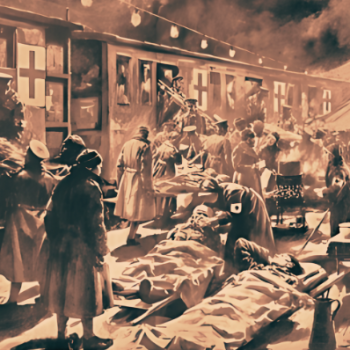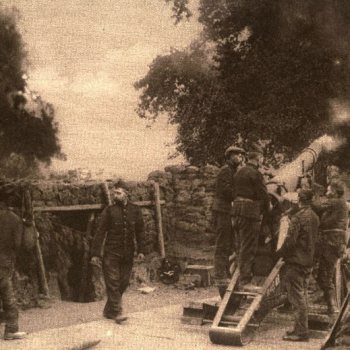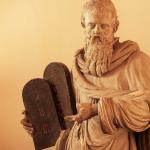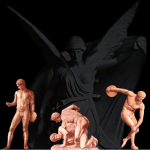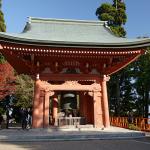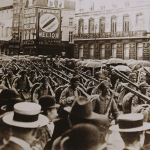For three days, Soh Kwang-pom’s body laid in state at his residence at 2819 Fourteenth Street. On Sunday, August 15, 1897, promptly at 3:30 in the afternoon, his casket was placed in a hearse and taken to Lee’s undertaking establishment on Pennsylvania Avenue.
There was a large crowd about the door of undertaker’s, and several police were necessary to keep the curiosity-seekers from crowding in. The casket was carried through the front room into the little chapel where the funeral services were to be held. It was Soh’s wish that his funeral be a simple one, and no one was present except those of the Society and his intimate friends.
The rested on a black catafalque. It was draped with a handsome silk American flag and decorated with the robes of state worn by Soh in life. On both ends there were crosses composed of white and pink roses.
In the front seats were Prince Min and Prince Eui-hwa, the second son of Yi Myŏngbok, the King of Korea. (Soh received an honorary A.M. degree at Roanoke College that June. It was the same school where Prince Eui-hwa studied.)[1] There was Mr. Pak (Soh’s secretary,) Mr. Surh, and a number of Korean students. Prince Min wore traditional attire. Everyone else wore black.
~
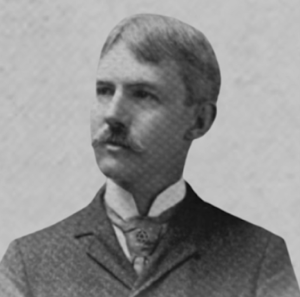
George M. Coffin.[2]
The first speaker was Soh’s friend, George Matthew Coffin, President of the Blavatsky Branch of the Theosophical Society (Washington, D.C.) Born in Charleston, South Carolina, Coffin was educated in the best private schools in that city. in 1864, at the age of sixteen, he enrolled in the South Carolina Military Academy (Columbia, S.C.) The Civil War being in progress, Coffin went with the battalion of state cadets into active service in the Confederate Army in November 1864, where he remained until the close of the war in April 1865. After the war, George A. Trenholm (Confederate States Secretary of the Treasury,) offered to sponsor Coffin’s continued education in Germany. The father of Coffin’s classmate, William L. Trenholm, the elder Trenholm had been much impressed by the young man’s academic record. Coffin, however, declined, as his efforts were needed to aid in the support of his widowed mother and sisters. With his three brothers, Coffin went to work in Columbia, South Carolina, but soon returned to Charlestown, where he worked as the only clerk in a leading commercial house. He successfully kept pace with that of his employer, quickly earning the confidence and esteem of the administrators of that firm. He was financially secure enough to marry Julia Haskell on November 9, 1871.[3]
In 1873 Coffin and Julia had their first child, a daughter they named Harriett. The global depression of 1873, however, soon caused a general economic decline, which compelled Coffin to start his own business in 1875, but this was not successful, so he entered an insurance office where he was employed. It was in 1875 that Coffin and Julia had their second child, George, but he died in infancy. In 1877 William was born; a year later Julia gave birth to twin, Edward and Frank, but Edward died a year later.[4] William would go on to study art at the Concordia School (Washington, D.C.,) and later under Paul Larens in France, and become a well-known illustrator for magazines. His “Coffin Girls” (illustrations of glamorous women,) were very popular.[5] He would end his own life in a hospital in St. Petersburg, Florida, in 1941.[6] Frank became a famous aviator, having been personally taught to fly by Orville Wright in Dayton, Ohio, in 1910.[7] After leaving the Wrights in 1912, Frank would perform a rare stunt when he flew under the Brooklyn Bridge. That same year he took the first motion pictures from an aircraft (which were used for newsreels.) He would die in Palo Alto, California, in 1960.[8]
In 1886 William L. Trenholm was made Comptroller of Currency by President Grover Cleveland. Trenholm, in turn, offered Coffin the position of Chief of the Division of Issues. Coffin accepted, and by July of that year the family had relocated to Washington, D.C. In 1888 Trenholm promoted Coffin to the head of the Reports Division, one of the largest and most important in the office.[9] In 1889 Coffin published The Handbook for Bank Officers, which was “recognized as a standard work on banking.”
It was here, on April 26, 1889, that Julia Coffin joined the Theosophical Society as a member-at-large.[10] The Gnostic Branch (Washington, D.C.,) led by Dr. Elliott Coues, had turned against Blavatsky, and W.Q. Judge revoked their charter. Judge then decreed that a new corporate body, the Theosophical Society and Universal Brotherhood, be incorporated in every state.[11] By June a new D.C. Branch, the Blavatsky T.S., was established with Anthony Higgins as its President.[12] After Higgins died in January 1891, he was replaced by J. Guilford White.[13] Coffin would join the Theosophical Society in December 1891.[14] The following year he published Silver From 1849 To 1892.[15] (In another work along these lines, Silver And Common Sense, Coffin elaborates on his argument for the gold standard.)[16] When White died in 1893, Coffin became President of the Blavatsky Branch. It was the year that he met Soh.[17]
~
“Mr. Soh was a man whose habits were simple and whose disposition was most unaffecting and modest,” said Coffin. “Mr. Soh did not desire great publicity; his retiring nature made this distasteful to him.”
Ralph L Lerch, another member of the Blavatsky Branch, spoke next. “To those who only look on the surface of things,” said Lerch, “it may appear that death is a complete ending of our existence; but to those who have felt of the soul that cannot be the case. Wise ones tell us that man is a god and his life is only a short sojourn on earth, it being a school of experience. Those who have had a glimpse of the inner life need not fear death, and of such a class was our departed friend.”[18]
Lerch then spoke of Soh’s career; how he came to America to see the fruits of civilization and sow the seeds among his own people. When he came again it was at a time of a stormy revolution in his kingdom. It was as a political exile that he reached America.
~
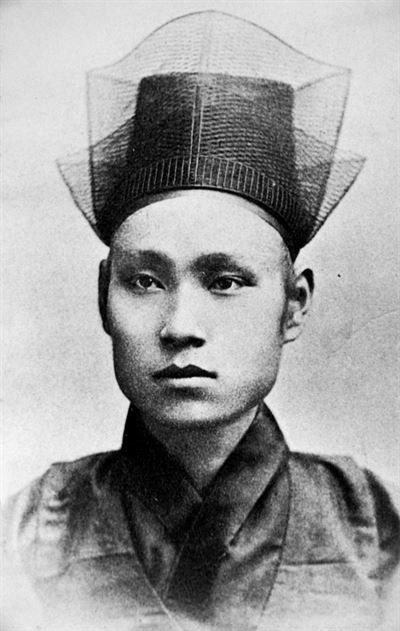
Soh Kwang-pom. (Source: Wiki)
Soh Kwang-pom (1859-1897) was born in into an aristocratic Korean family, the Daegu Seo clan. When he was a young boy Seo married Lady Kim of the Shin Andong Kim clan (but she died at a young age.)[19] He grew rapidly in stature and strength, leading all his comrades games and learning. He demonstrated a keen desire to learn, which made his father very proud. In 1874, when he was fifteen, he picked up an old dusty book which had been lying around for years. It told of a “strange land across the sea, [with] curious people.”[20] They were Christians, “horrible men” he was told, “who worshipped a strange god and ate children, who many years before had come into the country, secretly and in disguise, and made many converts for their strange god, until, growing strong, they had openly insulted the ancient gods of the land and the most sacred religious rites of the Koreans.” This created animosity for the foreigner in the isolated land of Korea. There was a law in Korea at the time which said that anyone found in possession of such a book would be put to death, but the book intrigued Soh, however, and became the catalyst for his pursuit of knowledge of the West. He remained silent about this book until he met a relative of his late wife, Kim Ok-gyun (1851-1894) who became a close friend. Kim Ok-gyun, who was very daring, did not hesitate to read the book. He, too, became enraptured with the accounts of these foreign lands, and they soon formed a secret society with a number of their friends joining them. Together they procured more works on the subject. Initially this was difficult, but it became easier over time, as they had a network of loyal servants who smuggled books into Korea by way of China. They learned more about the United States, and its “strange form of government,” and its technological advances (railroads, telegraphs, etc.) “which had a powerful influence in […] making the United States the favorite foreign nation among the Koreans.”
Korea’s Gojong (King Yi Myŏngbok) and Queen Min began to slowly open up the country in the early 1880s Around the time of the Treaty of Ganghwa, the men learned that Japan (regarded by the Korean government as a backwards nation,) had Westernized, and was fast becoming a “modern nation.” In late 1881, the Soh and Kim were granted permission to visit Japan to discern whether Japan was planning to invade Korea. They concluded that Japan would not invade Korea, because it was not yet strong enough militarily. They also believed that to make sure Korea survived when China was in decline, Korea “should follow in the footsteps of Japan and become a modern nation.”

Kim Ok-gyun. (Source: Wiki)
After five months in Japan, they received news of domestic disturbance in Korea. At that time there lived a powerful nobleman in Korea, Heungseon Daewongun who was the father of the Gojong and leader of the Conservative Party.[21] He was a man of great ability, it was said, but very cruel. He despised all foreigners (he was responsible for the death of over ten thousand Christians in Korea.)[22] Though Heungseon Daewongun had been in disgrace for a many years, a chance occurred that enabled him to regain his power. Queen Min had great influence with the Gojong, but she wished to “gain complete control of the king and the government,” and spent a great deal of money upon “diviners and soothsayers, for she was extremely superstitious and desired to gain the good will of the spirits.” She spent so much money, in fact, that there was none left to pay the soldiers. (Soldiers who already felt threatened by the forced influx of outside practices and foreign political norms.)
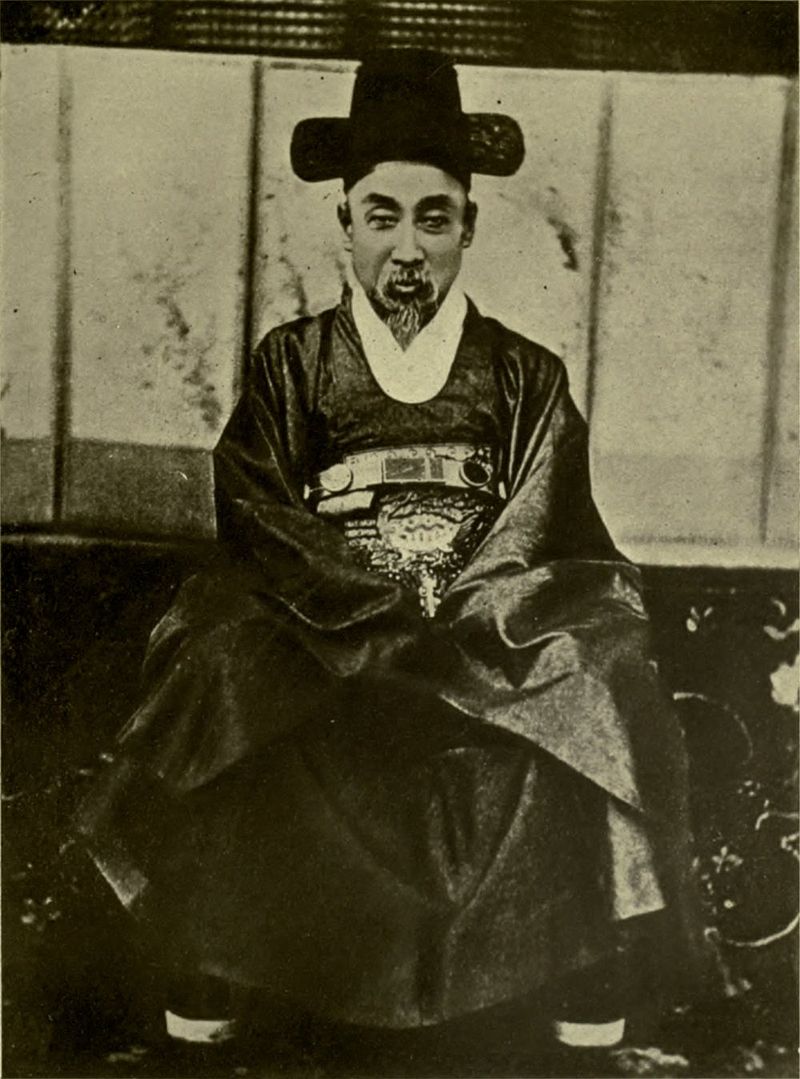
Heungseon Daewongun. (Source: Wiki)
This was the opportunity for Heungseon Daewongun. He led these angry soldiers in revolt, (Imo kulan,) and seized the Gojong. Then they tried to poison Queen Min, but she escaped. (One of her maids had impersonated her, and took the poison instead, and died in her place.) Heungseon Daewongun then attacked the Japanese embassy, but the Japanese fought their way through Seoul and reached the sea-coast where they embarked for Japan. Determined to avenge the attack upon their embassy.

The flight of the Japanese legation in 1882. (Source: Wiki)
Japan was determined to send a large force of troops to avenge the attack upon their embassy, Japan was quite prepared to send a large force of troops. When Soh learned of this, he went to the Japanese authorities to try to prevent them from attacking Korea. The Japanese listened to Soh’s arguments, and assured him that they would only send the troops to protect their embassy.
Soh and Kim joined the Japanese, but when they arrived at Chemulpo (the seaport town of Seoul) they found a large body of Chinese troops. (Qing China was Korea’s suzerain) They understood that if the Chinese entered Seoul, Korea would be in danger of losing her independence and become a mere province of China. This caused Soh and Kim to protest, and they finally persuaded the Chinese to wait until they could ask the Gojong whether he would let the Chinese enter Seoul. To do this Kim disguised himself as a peasant and made his way to Seoul. Heungseon Daewongun kept the king so well guarded, however, that it was impossible to approach him. (If Kim had been discovered, Heungseon Daewongun would have immediately beheaded him.) When Kim returned, and told of his failure, China intervened militarily in Korean affairs for the first time since 1636. Chinese troops suppressed the riots, restored order to Seoul, by capturing Heungseon Daewongun and sending him to China.[23] They also left a garrison of Chinese soldiers in Korea.
Soh and his friends returned to Seoul, where the Gojong received them with great favor, making Soh vice-president of the Home Department and conferring on him a high order of nobility (Takiyo,) which enabled him to be near the person of the king. Kim was also received with high honor and was made vice-president of the Foreign Department. Soh and Kim became two of the most noted young men in Korea, but they had their detractors.
The old men regarded them with horror and charged them with being traitors to their country, while the literary class and the extreme lower orders of the people were fanatical in their hate for Soh and his party. But he had won the favor of the king, and the young men of Korea were gathering rapidly to his standard, while many of the prominent men openly favored the new ideas.
Soh had been in Seoul but a few days when he discovered that the Mins (the party of Queen Min) had sold Korea to China, “making Korea more than ever a vassal of that country.” Soh and Kim were determined to thwart these designs, for if the Mins succeeded, Korea would remain a Hermit nations for many more years. They brought all the influence they could to bear on the Gojong, and persuade him to enter into a treaty with the United States that would insure the independence of Korea forever. Commodore
Robert Wilson Shufeldt (1850-1934,) of the United States Navy, was on board his vessel the U.S.S. Ticonderoga at Chemulpo, a short distance away.[24] When Soh and his friends obtained the Gojong’s consent, “the treaty was made almost before their enemies knew of their object or had time to resist them.” This treaty with the United States opened Korea up to the world. Soh and his party then sought to gain control of the army (which up to that time was commanded by Chinese officers.) Some fourteen young Koreans under the leadership of Soh Che Pil (a relative of Soh Kwang Pom) were sent to Japan to study the art of war. On their return they were made officers in the Korean army (replacing the Chinese officers.)
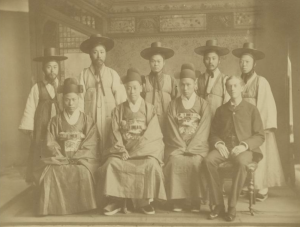
“Special mission from Korea to U.S.A., 1883. Prince Min Yong Ik, minister plenipotentiary. From left to right, bottom row: Hong Yong Sik (vice minister), Prince Min Yong Ik (minister plenipotentiary), Soh Kong Pom (secretary to prince), and Percival Lowell (escort to U.S.)”[25] (Source: Loc.gov)
In 1883 Soh finally realized his dream of visiting America, as the Gojong had decided to send an embassy there and commanded Soh to go with it. The embassy came to the United States, traveled across the continent, and was received by President Chester A. Arthur. When the embassy returned to Seoul on June 2,1884, “the whole population turned out to welcome the men who had been across the great water.” Soh learned that while he was away, his compatriots had established post-offices, and introduced the telegraph, steam-printing, newspapers, a police system, and many other things, “making a wonderful progress in throwing off the dead weight of the older civilization.” But Soh’s enemies were not idle. The Conservatives got possession of the Treasury, and had replaced the Korean officers in the army with Chinese officers once again. Then Min Yong Ik (one of the leaders of Soh’s party) defected to the enemy after a heated argument with Soh before the Gojong in which the king sided with Soh. Min Yong Ik vowed revenge, and the enemies of Soh and his party were greatly encouraged.
It was the custom of Korea to send a tribute to China every year which was usually guarded by several thousand Chinese troops. As the time for the departure of this tribute drew near, Soh’s enemies were determined to guard the tribute with Korean soldiers as to keep their loyal Chinese troops stationed in Seoul. When Soh and his friends learned of this plot against them, they knew that they would be doomed if it succeeded, for their enemies would not hesitate to banish or behead them. They knew they had to make another attempt at gaining control of the government, and “drive their enemies from power.”
On December 4, 1884, Hong Yeng Sik (vice-president of the embassy to the United States) was giving a grand banquet in his palace. Among those present was Min Yong Ik (the man who swore vengeance on Soh) who had recently been appointed commander of the palace guard battalion. In the middle of the stately banquet an alarm rang throughout Seoul. It was the signal for Soh’s revolt. Min Yong Ik rushed to the door, but was killed by a group of revolutionaries who were waiting for him. Soh caught him as he fell, a gesture of respect for a former friend. Pandemonium soon broke out in the banquet. Soh, Kim, and their friends, then seized the king’s palace (a stronghold in the center of the city.) The Korean soldiers inside the castle aided them in their defense. Soh and his men were trapped. The castle would soon be surrounded by Chinese soldiers. They had one hope of survival. Someone needed to go to Japan and enlist their help. That person was Soh.
“We will hold the castle and keep the king in our power, while you bring the Japanese to our rescue,” they said. Soh accepted the mission. Disguising himself, he left the city and hurried to the sea-coast, where he boarded a fast boat for the Island Kingdom. His hopes were crushed, as the Japanese hesitated, before ultimately refusing to come to the rescue of his comrades. They were not prepared to enter a war with China, which would have certainly followed.
Dispirited, Soh prepared to returned to Korea. As he was boarding a vessel to sail home, he saw a number of his friends who had escaped the general massacre of their party in Seoul. He learned that Kim had held the castle of the king against overwhelming odds, “hoping against hope and watching with strained eyes the east for the Japanese banners which never came.” Seeing that he could no longer hold the castle, on December 7, 1884, Kim told his men to escape if they could, and sought refuge himself in flight. One hundred of Soh’s followers died defending the castle. Nine hundred died outside in the streets of Seoul. Kim escaped to Japan, where he lived in constant danger of assassination. (He was shot in the back of the head by Hong Jong-u in 1893) Soh’s father’s was cast into prison, where he languished for ten years, and his palace was razed to the ground “until there was left no stone upon another.” Soh himself was condemned to death, but he managed to escape to the United States. (He would remain in exile for ten years.)[26] He briefly worked as the Secretary for the Korean Legation, but the early part of his time in America was devoted to study, as he enrolled as a student at Rutgers College (New Jersey.)[27] Afterward he returned to Washington, D.C.
In 1892 he became a naturalized citizen of the United States. (The first Korean-American to do so.) He then purchased a home in Washington, D.C. (2819 Fourteenth Street.)[28] In 1893, Soh became a member of the Blavatsky Branch.[29] Through this connection, he met Julia Coffin, through whom he furnished a series of articles called “Korean Stories,” for The Path (the American journal of the Theosophical Society.) He told Julia that they had “many stories of Masters or Adepts in his country […] where belief in Masters is universal among all classes.”[30] One of the most earnest members, Pom K. Soh presented the Branch with his private library and library furniture, including the Encyclopedia Britannica of twenty-four volumes and other valuable books.[31]
In September 1894, during the progress of the First Sino-Japanese War, the king of Korea invited Soh to Korea, granting him a full pardon.[32] Soh returned to America in February 1896 as the new Korean Minister to the United States.[33] Records indicate that he remained a Theosophist until the last, as he was at the Theosophical Society Convention in April 1897.[34] Soh died in his home on August 14, 1897 of acute consumption, after an illness of only a few days. The immediate cause of collapse, it was said, was over-exertion from a bicycle ride taken a little while after his return to Washington, D.C.[35]
~
“He never forgot his friends,” continued Lerch. “Those he had won in the better days of exile he ever remembered. Well his life fitted to the theories of the Society he loved. Man does not change, we hold, and the ties of friendship, once formed, should forever remain.”
Colonel R.E. Whitman, another member of the Blavatsky Branch spoke last. “Life is but a tent,” said Colonel Whitman, “which the Persian poet tells us is the resting place, and when the tent is struck the inmate passes on forever. The dark messenger—death—struck this tent before us very lightly. Its owner knew that any rough blast would level it to the ground, and the tenant was not even startled when the messenger knocked. Form changes, but force remains. This life that has gone was a thought center, and in the beginning was the world, thought, and consciousness.”
“This is but a single chapter the closing of a life,” said Coffin. “In the next chapter the soul indicts what has gone before.”
The casket was then lifted by attendants and carried through the glass doors at the front of the chapel, into the room immediately adjoining where the crematorium was located.[36]
SOURCES:
[1] “Roanoke College.” The Baltimore Sun. (Baltimore, Maryland) June 17, 1897; Eisenberg, William Edward. The First Hundred Years, Roanoke College, 1842-1942. Roanoke College. Salem, Virginia. (1942): 217.
[2] “George M. Coffin.” The Rand McNally Banker’s Monthly. Vol. XVI, No. 3 (September 1898): 192-193.
[3] “Married.” The Charleston Daily News. (Charleston, South Carolina) November 14, 1871.
[4] , Coffyn Marijane. The Coffyn-Coffin Dynasty. Christian Faith Publishing, Inc. Meadville, Pennsylvania. (2023): [Family No. 3626. George Matthewes Coffin Jr. and Julia Haskell Coffin/ (4881) Harriet Eva. (4882) George Matthewes. (4883) William “Bill” Haskell. (4884) Edward Jenkins. (4885) Frank Trenholm Haskell.
[5] (The Lady With The Lorgnette.) “The Mirrors Of Stageland.” Theatre Magazine. Vol. XXXVI, No. 6 (December 1922): 386-418.
[6] “Haskell Coffin Dies In Plunge Out Of Window.” The Roanoke Times. (Roanoke, Virginia) May 13, 1941.
[7] Frank writes: “My father, George M. Coffyn, was vice president of the Phoenix National Bank of New York; and among his directors was Andrew Freedman, one-time owner of the New York Giants. Father introduced me to Mr. Freedman, who was also a director of the newly formed Wright Company, and I boldly asked for a letter to the famous Wright brothers.” [Coffyn, Frank T. “Flying With The Wrights.” World’s Work. Vol. LVIII, No. 12 (December 1929) 80-86.]
[8] “Frank Coffyn, Last Of Men Flying With Wrights, Dies.” The Oakland Tribune. (Oakland, California) December 11, 1960.
[9] Holmes, Henry Schulz. “The Trenholm Family.” The South Carolina Historical and Genealogical Magazine. Vol. XVI, No. 4 (October 1915): 151–163.
[10] Theosophical Society General Membership Register, 1875-1942 at http://tsmembers.org/. See book 1, entry 4742. (website file: 1B:1885-1890) Julia H. Coffin. (Universal. 1421 20th Street, N.W. Washington, D.C. [4/26/1889.])
[11] “A New Theosophical Society.” The Tennessean. (Nashville, Tennessee) July 29, 1889.
[12] “Blavatsky And Dr. Coues.” The Evening Star. (Washington, D.C.) June 17, 1889.
[13] “Theosophical Activities.” The Path. Vol. V, No. 11 (February 1891): 355-360; “Mirror Of The Movement.” The Path. Vol. VIII, No. 5 (August 1893): 153-160.
[14] Theosophical Society General Membership Register, 1875-1942 at http://tsmembers.org/. See book 1, entry 7711. (website file: 1C:1890-1894) George M. Coffin. (Universal. 1421 20th Street, N.W. Washington, D.C. [12/4/1891.])
[15] Coffin, George M. Silver From 1849 To 1892. McGill & Wallace. Washington, D.C. (1892.)
[16] Coffin, George M. Silver And Common Sense. Librarian of Congress. Washington, D.C. (1895.)
[17] Theosophical Society General Membership Register, 1875-1942 at http://tsmembers.org/. See book 1, entry 6521. (website file: 1C:1890-1894) Marie A. Watson. (2/6/1891); “Mirror Of The Movement.” The Path. Vol. VIII, No. 5 (August 1893): 153-160; Report Of Proceedings Of The Theosophical Society American Section Eighth Annual Convention. (April 22-April 23, 1894.)
[18] “Rites Over Pom Soh.” The Washington Post. (Washington, D.C.) August 16, 1897.
[19] Renick, E. I. “A Korean Case.” The American Law Review. Vol. XXXIII, No. 6 (November-December 1899): 369-375.
[20] Gordon, Haddo. “A Young Corean Rebel.” Lippincott’s Monthly Magazine. Vol. LV, No. 5 (May 1895): 662-668.
[21] Noble, Harold J. “The Korean Mission To The United States In 1883.” Transactions Of The Korea Branch Of The Royal Asiatic Society. Vol. XVIII. (1929): 1-21.
[22] Frazar, Everett. Korea And Her Relations To China, Japan And The United States. Chronicle Book And Job Printing. Orange, New Jersey. (1884): 16.
[23] Lew, Young Ick. A Brief History Of Korea: A Bird’s Eye View. The Korea Society. New York, New York. (2000): 18-19.
[24] Paullin, Charles Oscar. “The Opening Of Korea By Commodore Shufeldt.” Political Science Quarterly. Vol. XXV, No. 3 (September 1910): 470-499.
[25] Foulk, George Clayton, Photographer. South Korea, Prince Min Yong Ik and Diplomats. Republic of Korea, 1883. [Place of Publication Not Identified: Publisher Not Identified] Photograph. https://www.loc.gov/item/2021670695/.
[26] Gordon, Haddo. “A Young Corean Rebel.” Lippincott’s Monthly Magazine. Vol. LV, No. 5 (May 1895): 662-668.
[27] “From Exile To Honor.” The Los Angeles Times. (Los Angeles, California) February 9, 1896.
[28] “Pom K. Soh’s Last Wishes.” The Evening Star. (Washington, D.C.) August 20, 1897.
[29] Theosophical Society General Membership Register, 1875-1942 at http://tsmembers.org/. See book 1, entry 9086. (website file: 1C:1890-1894) Pom K. Soh. Blavatsky Branch. [1019 P. Street, N.W. Washington, D.C. (3/2/1893.)]
[30] Soh, Pom K. “Korean Stories.” The Path. Vol. VIII, No. 4 (July 1893): 103-105; Soh, Pom K. “Korean Stories.” The Path. Vol. VIII, No. 5 (August 1893): 150-152.
[31] American Section Theosophical Society Seventh Annual Convention. Aryan T.S. Hall, Headquarters, And A Scottish Rite Hall, New York, April 23 and 24, 1893. Report Of Proceedings.
[32] Gordon, Haddo. “A Young Corean Rebel.” Lippincott’s Monthly Magazine. Vol. LV, No. 5 (May 1895): 662-668.
[33] “Corea’s New Minister.” The San Francisco Examiner. (San Francisco, California) February 8, 1896.
[34] “The Theosophists Convention.” The New York Tribune. (New York, New York) April 18, 1897.
[35] “Pom Kwang Soh Dead.” The Washington Post. (Washington, D.C.) August 14, 1897.
[36] “Rites Over Pom Soh.” The Washington Post. (Washington, D.C.) August 16, 1897.


